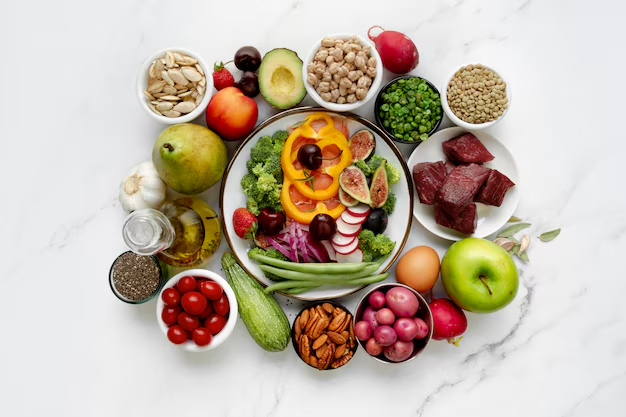Maintaining a balanced diet is crucial for overall health and well-being. While supplements are
popular, natural foods offer a wealth of vitamins, minerals, and other essential nutrients that are
easier for the body to absorb and utilize. Adding multivitamin foods to your meals not only
supports various bodily functions but also reduces dependency on synthetic supplements.
This article highlights the best multivitamin foods, their benefits, and how to incorporate them
into your daily diet.
- Spinach – A Leafy Green Nutrient Powerhouse
Spinach becomes an excellent provider of vitamins A, C, K, and folate. It also provides
magnesium, iron, and calcium, making it one of the healthiest greens to include in your diet.
Key Benefits:
● Enhances vision and skin health with vitamin A and lutein.
● Strengthens bones with vitamin K and calcium.
● Boosts immunity with vitamin C.
How to Include It:
● Add fresh spinach to salads or smoothies.
● Use it as a base for soups or pasta dishes. - Eggs – Nature’s Multivitamin in a Shell
Eggs are among the most nutritious foods, offering vitamins B12, D, A, and E, along with high-
quality protein and healthy fats.
Key Benefits:
● Improves bone health with vitamin D.
● Supports brain function with choline.
● Provides energy and aids muscle repair.
How to Include It:
● Boil eggs for a quick snack.
● Make omelets or scrambled eggs for breakfast.
● Add them to salads or baking recipes.
- Sweet Potatoes – The Vitamin A Booster
Packed with beta-carotene, vitamin C, and B6, sweet potatoes are a delicious and nutritious
food for overall health.
Key Benefits:
● Promotes healthy skin and vision with beta-carotene.
● Boosts immunity with vitamin C.
● Regulates blood sugar levels due to their low glycemic index.
How to Include It:
● Roast them for a crispy snack.
● Use mashed sweet potatoes as a side dish.
● Incorporate them into stews or desserts. - Almonds – Tiny Nutritional Powerhouses
Almonds are rich in vitamin E, magnesium, and healthy fats. These nuts are ideal for snacking
and improving heart health.
Key Benefits:
● Protects cells from oxidative damage with vitamin E.
● Strengthens bones with calcium and magnesium.
● Supports heart health with healthy fats.
How to Include It:
● Snack on a handful of almonds daily.
● Add sliced almonds to cereals, salads, or desserts.
● Use almond butter in smoothies or spreads. - Citrus Fruits – The Vitamin C Champions
Citrus fruits like oranges, lemons, and grapefruits are loaded with vitamin C, folate, and
potassium, making them essential for boosting immunity.
Key Benefits:
● Improves collagen production and skin health with vitamin C.
● Reduces kidney stone risk with potassium.
● Enhances immunity and fights free radicals.
How to Include Them:
● Drink freshly squeezed juices.
● Add citrus slices to salads or desserts.
● Use lemon zest in dishes for added flavor. - Fatty Fish – A Treasure Trove of Omega-3s and Vitamins
Fatty fish like salmon, mackerel, and sardines are rich in omega-3 fatty acids, vitamin D, and
B12, essential for heart and brain health.
Key Benefits:
● Reduces inflammation and improves heart health with omega-3s.
● Strengthens bones and boosts immunity with vitamin D.
● Supports brain function and reduces cognitive decline risks.
How to Include It:
● Grill or bake fish as a main dish.
● Add canned fish to salads or sandwiches.
● Use it in stews, curries, or pasta. - Quinoa – The Superfood Grain
Quinoa is a gluten-free grain packed with protein, iron, magnesium, and B vitamins. It serves as
a complete protein, containing all nine essential amino acids.
Key Benefits:
● Promotes muscle health and energy with protein and B vitamins.
● Enhances heart health with magnesium and iron.
● Provides sustained energy with its low glycemic index.
How to Include It:
● Use quinoa as a base for salads or bowls.
● Substitute it for rice in main dishes.
● Incorporate it into soups or stews.
Another healthy treasure:
Legumes – A Plant-Based Nutrient Powerhouse
Legumes, such as lentils, chickpeas, and black beans, are packed with B vitamins, iron,
magnesium, and protein. They’re deliciously an excellent option for vegetarians and vegans.
Key Benefits:
● Provides sustained energy with complex carbohydrates.
● Supports red blood cell production with iron and folate.
● Promotes muscle repair and growth with plant-based protein.
How to Include It:
● Make lentil soup or stews.
● Add chickpeas to salads or roast them for a crunchy snack.
● Use black beans in wraps, burritos, or veggie burgers
Why Multivitamin Foods Are Better Than Supplements

Natural multivitamin foods offer numerous advantages over synthetic supplements:
- Synergistic Nutrients: Vitamins and minerals in food work together to enhance
absorption. For example, vitamin C-rich foods (citrus fruits) boost iron absorption from
leafy greens. - Bioavailability: Nutrients in whole foods are more easily absorbed than those in
supplements. - Additional Benefits: Multivitamin foods provide fiber, antioxidants, and phytonutrients
that supplements lack.
Tips for Maximizing Nutrient Absorption
- Pair Foods Wisely: Combine healthy fats (nuts or olive oil) with fat-soluble vitamins (A,
D, E, and K) for better absorption. - Cook Strategically: Avoid overcooking vitamin C-rich foods like citrus and spinach, as
heat can destroy the vitamin. - Diversify Your Plate: Eating a variety of multivitamin foods ensures you get a wide
range of nutrients.
Addressing Common Concerns
Are Multivitamin Foods Enough for Everyone?
While these foods meet the nutritional needs of most individuals, specific groups (pregnant
women, elderly, or those with deficiencies) may require supplements. Do consult a Diet
professional before making dietary changes.
What About Food Allergies?
If you’re allergic to certain foods like nuts or eggs, alternatives such as seeds, fortified cereals,
or plant-based options like soy can provide similar nutrients.
Adding multivitamin-rich foods to your diet is a natural and effective way to improve your health
and well-being. Each of these seven foods offers a unique blend of vitamins and minerals,
ensuring your body gets the nourishment it needs.
By diversifying your meals, cooking strategically, and combining foods wisely, you can maximize
the benefits of these nutrient-dense options. Make these multivitamin foods a regular part of
your diet and take a step towards a healthier, more vibrant life!


